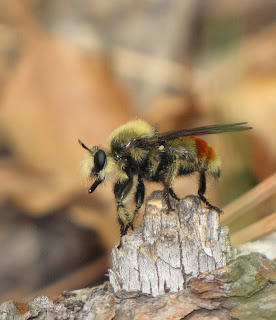Once the general public gets wind of your expertise in entomology, you are invariably inundated with requests for identifications of specimens, images, even fuzzy recollections that are then related to you. The digital age has made entomologists and naturalists much more accessible, and I believe that is a very good thing. Exterminators have always been accessible. It is also a good thing for those of us answering inquiries because it often presents a challenge, or a window to species from faraway lands, or in some cases represents a new or potentially invasive species.
Semanotus amethystinus (Amethyst Cedar Borer) from "Sara S." in Portland, Oregon via What'sThatBug.comOne of my regular "clients" is the webmaster for What's That Bug?, a very popular website that receives submissions from all over the globe. Daniel Marlos, who runs the site, started it on a relative lark as an example of pop culture. He quickly found he was filling a huge void, but had little knowledge of entomology himself. Over the years that has changed dramatically, and Daniel can now identify most common critters. He is better at identifying Australian insects and arachnids than I am. Still, he gets stumped every once in awhile, and will e-mail me for help.

Much of the time, I am clueless, too, but I enjoy the investigative work of coming up with an answer if I can. Take this submission from "Sweetpea" in Montreal, Quebec, Canada, for example. I did not recognize this longhorned beetle and thought it might be something exotic that found its way there in the fashion of the notorious Asian Longhorned Beetle. A quick search of Bugguide.net proved it was actually the native "Linden Borer," Saperda vestita. I learned something in the process of helping.
Here's another example. My response to Daniel is under the images.
"Daniel:
We were both wrong! You thought it was a clerid or a tenebrionid. I thought for certain it was a spider beetle (Anobiidae: Ptininae or Ptinidae). Turns out it is a longhorn! Here:
Bugguide.net
Crazy. I knew it looked familiar, but it took looking in an old, dusty copy of Essig’s Insects and Mites of Western North America to find a figure that matched.Would love to share these images on Bugguide and maybe in a blog post. Thanks.
Eric"
Sometimes I even get forwarded e-mails as the chain of included experts expands even longer. One of my friends in Arizona sent me the image below that depicts an ovipositing female bee fly at the Gilbert Water Ranch near Phoenix, Arizona.
© Laurie NesselI am increasingly impressed and delighted by how observant and curious many people are about the invertebrate world.
Occasionally, friends will simply share images they think I would enjoy, like this male Anise Swallowtail photographed by David M. Elwonger on the summit of Signal Butte in the Pike National Forest here in Colorado. I had not been aware that the species occurred east of the Rockies prior to his e-mail to me.
© David M. ElwongerPlease, keep the proverbial cards and letters coming, there is no such thing as a stupid question or unimportant observation. At the very least, if it is important to you, then it is important to me, too.















